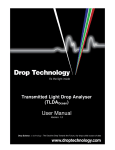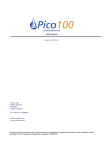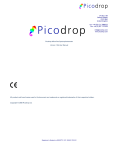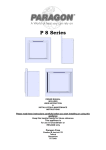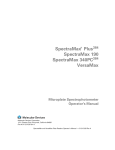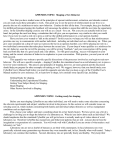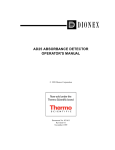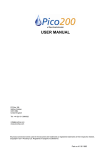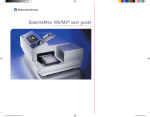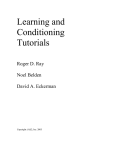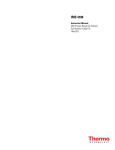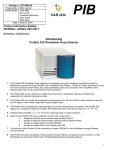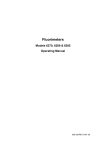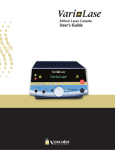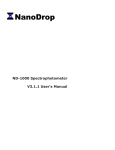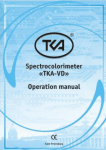Download USER MANUAL CUBE Microlitre Spectrophotometer
Transcript
USER MANUAL CUBE Microlitre Spectrophotometer User Manual NOTES CONTENTS CE DECLARATION OF CONFORMITY ........................................................................ 5 ESSENTIAL SAFETY NOTES ....................................................................................... 6 Potential Safety Hazards........................................................................................... 7 Electrical.................................................................................................................. 7 Hazardous Substances ............................................................................................. 7 Solvent Compatibility .............................................................................................. 7 Instrument case and paintwork ................................................................................. 7 INTRODUCTION ...................................................................................................... 8 General ................................................................................................................... 8 Principle of Operation .............................................................................................. 8 Measurement Modes .............................................................................................. 9 Principle of Measurement ........................................................................................ 9 Micro-sample accessory .......................................................................................... 9 User and Data Management ..................................................................................... 11 INSTALLATION ....................................................................................................... 12 Unpacking.............................................................................................................. 12 Positioning ............................................................................................................. 12 Hardware installation (if not already pre-assembled) ................................................ 13 Assembling the pipette holder................................................................................. 13 Connecting the fibre-optic cables ............................................................................ 13 Connection and loading the software to your PC...................................................... 15 Minimum specification for the PC ............................................................................ 15 APPLICATION MODES ........................................................................................... 16 Getting Started...................................................................................................... 16 Correct pipette use and sample handling................................................................. 17 Nucleic Acid Measurement..................................................................................... 18 Export of data to Excel ............................................................................................. 19 Direct Protein Measurement.................................................................................... 19 Export of data to Excel ............................................................................................. 20 Picodrop CUBE User Manual, version 1.0, May 2013 Page 3 Indirect Protein Measurement ................................................................................. 21 Full Scan.................................................................................................................. 24 Zoom ..................................................................................................................... 25 Graph overlay and Normalisation of wavelength (background correction) ............... 25 Export of data to Excel .............................................................................................. 25 ACCESSORIES......................................................................................................... 27 Pipette tips.............................................................................................................. 27 Other ..................................................................................................................... 27 MAINTENANCE..................................................................................................... 28 Cleaning................................................................................................................. 28 Quick Clean’ procedure for sample holder: ............................................................. 28 Troubleshooting .................................................................................................... 28 Power indicator does not light................................................................................. 28 Inconsistent result.................................................................................................. 28 Lens cleaning procedure......................................................................................... 30 Connection Lost message ....................................................................................... 31 Communications Error message............................................................................. 31 Ethernet Connection failed .................................................................................... 31 SPECIFICATIONS .................................................................................................... 33 APPENDIX 1 – APPLICATIONS.................................................................................. 34 Measuring Nucleic Acid Concentration and Purity .................................................... 34 Protein Measurements ........................................................................................... 35 Indirect measurement ............................................................................................. 35 Direct measurement............................................................................................... 35 Molar Extinction Coefficients vs. Absorbances for 1% Solutions ............................... 36 Measuring a Protein or Protein Mixture with Unknown Extinction Coefficients.......... 37 APPENDIX 2 – SETTING IP ADDRESSES...................................................................... 38 Setting IP addresses in a Windows Vista system........................................................ 38 Setting IP addresses in a Windows XP system............................................................ 40 Setting IP addresses in a Windows 7 / 8 system.......................................................... 42 Picodrop CUBE User Manual, version 1.0, May 2013 Page 4 CE DECLARATION OF CONFORMITY Product: Optic Coupled Spectrometer Type: SWIR, NIR, VIS/NIR, UV/VIS. We declare that the above-specified systems are compliant with the regulations of the European Community when installed as a system. The devices are compliant with the following standards: LV Directive 72/23/EC EMC Directive 89/336/EC Note: This declaration of conformity becomes invalid if: The devices are installed, modified, complemented or changed in a manner which has not been permitted in the devices “User Manual”. In case of improper usage. Picodrop Ltd. Picodrop CUBE User Manual, version 1.0, May 2013 Page 5 ESSENTIAL SAFETY NOTES All product and brand names used in this document are trademarks or registered trademarks of their respective holders. Please read carefully before installing or operating this instrument – if in doubt seek advice. 1. This instrument is designed for operation by trained personnel who are aware of the principles and applications involved. For further help and advice please contact your distributor or visit www.Picodropsytems.com 2. This instrument is a sensitive optical and electronic instrument designed for use in a laboratory environment. Careful adherence to the installation instructions must be observed. If in doubt contact a relevant and competent authority before proceeding. 3. Operators of this instrument must be trained in (a) general laboratory safety practices, (b) the specific safety requirements of the instrument and any other equipment being used and (c) the risks and safe practices for the analysis being undertaken, including those associated with sample handling. If the equipment is used in a manner not specified by the manufacturer, the protection provided by the equipment may be impaired and any warranty invalidated. 4. This instrument is designed for minimal maintenance, which must be carried out carefully following the procedures detailed in this manual. All safety instructions detailed in these procedures as well as those for the area or environment where the work is being carried out must be observed. 5. Other than for those items defined in the maintenance procedures there are no user serviceable items in this instrument. Removal of covers and attempted adjustment, service or modification by unqualified personnel will invalidate any warranty and incur additional charges for repair. 6. Reference should always be made to the health and safety data for any chemicals or reagents used. All advice and warnings on the handling storage, use and disposal of these must be carefully observed. When not available this data must be requested from the supplier before proceeding. 7. It is important that good laboratory practice is observed when handling samples, chemicals, reagents and ancillary equipment in order to carry out measurement and analysis with this instrument. Suitable personal protective equipment (PPE) must be used at all times and in all circumstances. 8. If it is suspected that safety protection has been impaired in any way, the instrument must be made inoperative and be secured against any intended operation, with clear warnings as to this state. The fault condition must be reported to the appropriate servicing authority as soon as possible. In all such reports the model name/number and serial number must be quoted. Picodrop CUBE User Manual, version 1.0, May 2013 Page 6 Potential Safety Hazards Electrical • • • Standard electrical safety precautions should be observed. Ensure that the proper voltage is being supplied before turning the instrument on for the first time. The device must be connected to a grounded socket. • Do not touch any switches or outlets with wet hands. • • Switch the instrument off at the mains supply before disconnecting the AC power cord. Unplug the instrument prior to maintenance, cleaning up any major liquid spills and prior to servicing any of the electrical or internal components. If in doubt about any aspect of the electrical installation consult a qualified electrician. Only qualified personnel should perform electrical servicing. • Hazardous Substances Reference should always be made to the health and safety data for any chemicals or reagents used. All advice • and warnings on the handling storage, use and disposal of these must be carefully observed. When not available this data must be requested from the supplier before proceeding in any way. • The relevant safety regulations must be observed when handling pathogenic samples, radioactive materials or other substances hazardous to health. The correct and safe disposal of waste materials must be observed. • Before returning any item for service, repair or calibration a Decontamination and Safety Clearance Declaration must be completed to ensure the duty-of-care can be maintained for those who will be handling equipment used for such purposes. Solvent Compatibility Instrument case and paintwork Compatible Solvents Acetic Acid (dilute) Acetone Acetonitrile Benzene Bleach Butanol Carbon Tetrachloride Chloroform Ethanol Ether HCl (dilute) Hexane HNO3 (dilute) Isopropanol Methanol N-Propane Sodium Hydroxide Sodium Hypochlorite Toluene Incompatible Solvents Hydrofluoric Acid and derivatives Picodrop CUBE User Manual, version 1.0, May 2013 Page 7 INTRODUCTION General This instrument is a low volume, short path length spectrophotometer that provides the user with the facility to recover their sample after measurements have been taken using in-tip UV pipette technology. It is a full spectrum (220 – 850nm) UV/Visible spectrophotometer which allows for measurements of many sample types commonly analysed in the laboratory. Because of its ultra-small sample requirement and ability to recover the samples, the product is ideally suited to life science applications including DNA, RNA and protein measurements and includes a sampling accessory and software dedicated to these applications. Principle of Operation This instrument is one of a new type of spectrophotometer that integrates a high resolution CCD Array detector with fibre-optic coupled sampling accessories. Because there are NO MOVING PARTS the inherent reliability and durability of these instruments far surpasses those of traditional design, calibration is fixed in manufacture so no delays are needed at switch-on for a lengthy auto-cal procedure; while maintenance and service requirements are truly minimal. The product uses a press-to-read system with a pulsed xenon lamp that is only powered up when a measurement is being made. This not only saves energy compared to spectrophotometers with lamps that are continuously on, but gives a much longer lamp life (in excess of 10 years) with far higher UV energy levels. Light from the xenon lamp is transmitted to the sampling accessory via a fibre-optic cable. Here some wavelengths are absorbed by the sample, while the light transmitted through it is then returned to the polychromator and CCD Array detector by another fibre-optic cable on the other side of the accessory. This enables the sampling accessory to be remote from the instrument and for dedicated, application specific sampling accessories to be designed without the restrictions of the traditional light-tight sample chamber being required. This also simplifies and speeds up operation as there is now no need to keep opening and closing sample chamber lids for each measurement. Picodrop CUBE User Manual, version 1.0, May 2013 Page 8 This configuration also isolates the lamp from the sensitive optics of the polychromator, so problems of heat and stray light from the light source become a thing of the past. The polychromator in the instrument is effectively a sealed-unit with a single fibre-optic cable as input and a single ribbon cable as output. Compare this to traditional spectrophotometers where the lamp is usually an integral part of the monochromator, requiring forced cooling and so introducing dust and contamination into the optics, increasing maintenance, degrading performance and shortening its working life. As well as removing all moving parts, another major advantage of the polychromator used in the product over the monochromator used in traditional spectrophotometers is the speed of measurement, with a full scan being possible in around 2 seconds; while the 3648 element CCD Array ensures a fine resolution of the detail. Measurement Modes This instrument has modes for measuring Nucleic Acids as both double stranded DNA (dsDNA) and single stranded DNA (ssDNA), as well as RNA. The concentration and purity ratio of the nucleic acid are reported along with a full wavelength scan, all in a measurement time of 2 seconds! Direct Protein measurements can be made against a general Absorbance reference as well as BSA, IgG, Lysozyme or user-entered reference. Indirect Protein measurements can be made using the Bradford or Lowry protocols as well as against user defined settings. Full wavelength scan is also available, with zoom and overlay facilities. A wavelength may be selected for normalization or background correction. More information on applications is provided in the Appendix. Principle of Measurement Micro-sample accessory Using a novel through-the-tip measurement principle, samples, as small as 2.5µl, can be measured and still be retained for further processing or other analysis. Using the specially designed micro-sampling accessory samples remain protected and contained within the special UV transmitting pipette tips where they are measured. They do not have to be dispensed so there is no risk of the cross contamination or carry- over that can occur with methods that require dispensing the sample onto a platform or pedestal. There are no caps or covers to be placed over the sample, so measurement is quick and easy. Precious samples can be handled within a sterile environment and are completely recoverable. Using individual disposable tips for each sample means there is no need to clean up after each measurement, removing any possibility of carry-over or contamination and making this the fastest and most efficient method of analysis. Picodrop CUBE User Manual, version 1.0, May 2013 Page 9 A 2.5µl sample is drawn up directly into the UV pipette tip using the supplied pipette. The pipette is placed into the holder, which automatically positions the tip in a light beam, emitted from a fibre-optic cable connected to the holder. The light source is a pulsed xenon lamp housed in the instrument and the light path through the tip is 1mm. The light passes through the sample, still retained in the tip, and the light transmitted through it is collected by a second fibre-optic cable on the opposite side of the holder. The transmitted light is then analysed in the polychromator-based spectrophotometer, also housed in the instrument, where the Absorbance, Concentration, Purity Ratio and other values are calculated. The instrument is controlled using the supplied software run from a PC or laptop via an Ethernet connection. The pipette, tips and pipette holder accessory are all critical components in making accurate and reproducible measurements of micro sample-volumes including DNA/RNA and Protein measurements. The tips are made from a special UV/visible transmitting optical grade polymer that is also significantly more dimensionally stable and reproducible than normal tips – do not use alternatives. ONLY USE THE PIPETTE AND TIPS SUPPLIED BY THE ORIGINAL EQUIPMENT MANUFACTURER – DO NOT USE ALTERNATIVES AND DO NOT AUTOCLAVE TIPS For applications where larger sample volumes are available a number of optional sampling devices can be used with this spectrophotometer. Picodrop CUBE User Manual, version 1.0, May 2013 Page 10 User and Data Management For full traceability all results are stored with the date and time of measurement along with an incrementing number. This can be further enhanced by an alpha-numeric ‘name’ that can also be appended to every sample. When making measurements, results can be viewed in real-time, or exported in a tab- delimited Microsoft Excel format for archiving or presentation in other programmes. All spectrum scans have deep levels of zoom available in both the x and y axis ensuring the required level of detail can be viewed. Graphical printouts can be made on low-cost PC printers and include the scan, results, settings and sample information, giving a concise hard-copy record when required. Picodrop CUBE User Manual, version 1.0, May 2013 Page 11 INSTALLATION Unpacking Remove the instrument from the packaging and ensure the following items are included. 1. CUBE Spectrophotometer Unit 2. Pipette 3. Pipette Holder and Base 4. Pipette Guide Collar 5. Box of 96 UV pipette tips 6. Ethernet Cable 7. Fibre-Optic Cables with Connectors (2) 8. Mains cable with Plug 9. 12V Power Supply (universal input voltage) 10.1.5mm Allen Key (for maintenance) 11. Lens Extractor Tool (for maintenance) 12. Software Disk Any shortages or damage must be reported to the carrier and your local distributor as soon as possible Keep all packaging materials in case the unit has to be re-shipped or stored at a later date; always place items in clean polythene bags before packing to avoid the ingress of fibres and dust from the cardboard. Positioning The ideal installation environment for the instrument and its accessories will be clean, dry and dust free with the temperature and humidity controlled. All items should be sited away from windows where extreme and rapidly changing temperatures can be experienced even in a controlled environment. The spectrophotometer should be placed on a rigid, flat, clean surface. Make sure that the instrument is completely stable. Where the ideal conditions cannot be met, the instrument and its accessories must be given additional protection both when in use and idle. Protection suing dust covers is always recommended when equipment is not in use. Where conditions are less than ideal routine maintenance and cleaning may be required more frequently. The instrument requires a bench area of just 30 x 16 cm and the micro-sample accessory just 78 square centimeters. Further consideration should be given to the space for, and location of, the PC required to drive the product, as well as other peripheral devices such as printers etc. When choosing a location thought should also be given to the additional space required for sample preparation and the equipment and reagents that may be required for this, as well as to the proximity of a suitable and safe waste disposal system. The instrument should be positioned within 2.0 meters of an easily accessible mains socket, preferably with an isolating switch. The Ethernet cable supplied is 1 metre long so the PC will need to be positioned so the Ethernet port can be reached by this cable. Picodrop CUBE User Manual, version 1.0, May 2013 Page 12 Please ensure that the ventilation slots of the device remain clear and free to vent at all times. A space of at least 10cm should be left around the spectrophotometer. The space underneath the instrument must be kept clear of paper, loose material and dust build-up. The ambient temperature should be between 10°C and 30°C, the humidity between 0% and 95% non-condensing. Hardware installation (if not already pre-assembled) Assembling the pipette holder The pipette holder has been dismantled and disconnected for shipment. Fix the tubular pipette holder to its round base by simply screwing it on. Connecting the fibre-optic cables Important 1. Although they carry out a similar interconnection function to electrical cables, fibre optic cables are made of glass and CANNOT be handled in a similar manner to metal based conductors. 2. Do not exceed the maximum bend radius for the cable, in use or in storage. This is typically 300 times the cladding diameter, so for core diameters of 100µm to 600µm this approximates to a bend radius of 4cm (100µm) to 20cm (600µm), but is dependent on the detail of the construction of each cable type. The fibre optic cables on this instrument have a core of 100µm, so the bend radius is 4cm. 3. Ensure all optical surfaces are clean and dust free before making any connections. Always replace dust-caps on fibre ends and instrument SMA905 connectors when fibre optic cables are disconnected. 4. Do not use tools to tighten the screw locking ring on SMA905 connectors, but do ensure they are firmly hand tight. 5. Do not pull on the cable to remove it when disconnecting, only use the connector screw locking ring. Picodrop CUBE User Manual, version 1.0, May 2013 Page 13 6. Do not subject the cable to axial twisting in use, installation or storage. Spool or un-spool long lengths of cable in a figure-of-eight (as each part of the ‘eight’ puts an opposite twisting moment in the cable) turn the ‘eight’ over when carrying out the reverse process. 7. Do not subject the cable to pulling stress during installation or use. Fibres are usually stronger in direct tension relative to the cross section, but when fibres are small it is very easy to break them. Unfortunately each cable construction will have its own limits and it is difficult to give fixed rules for this, so minimizing pulling stress is important. 8. Try to restrict movement of cables during the period a measurement is being made. 9. Take extra care not to bend or crush cables at their exit point from probe heads, in use and storage, and do not support the weight of a probe by the cable. 10. Do not use any cable, cable assembly or probe beyond its specified performance limits or outside of its environmental operating and storage conditions. If in doubt consult your supplier, alternatives may be available, specials suitable for most situations can often be supplied or alternative procedures developed. Procedure Fitting the two fibre-optic cables to the instrument Connect the SMA to SMA launch cable from the lamp socket (top right) by pushing the connector into the socket and hand-tighten the knurled ring completely to hold the connector in place. Do not use tools to tighten the knurled ring. No polarity or orientation needs to be observed. Connect the MTP to SMA collection cable to the detector (bottom left) by pushing into the slot; note that to remove it, the shroud should be pulled back Fitting the fibre-optic cable to the pipette holder Ensure that the launch cable from the lamp socket is connected to the pipette holder with the holder slot facing forward and on the right hand side of the holder. Ensure that the collection cable to the detector is connected to the pipette holder with the holder slot facing forward and on the left hand side of the holder (see diagram In both cases, push the connector into the socket and hand- tighten the knurled ring completely to hold the connector in place. Do not use tools to tighten the knurled ring. The completed assembly: Always use the instrument with the pipette holder facing toward you and without excessive twisting of the fibre optic cables. Note that the fibre optic cables on this instrument have a core of 100µm, so the bend radius is 4cm. Picodrop CUBE User Manual, version 1.0, May 2013 Page 14 Connection and loading the software to your PC The instrument has an external switch-mode power supply that will accept any mains voltage from 100 to 240V AC at 47 to 63Hz. If the correct mains plug has not been supplied an alternative lead or plug may be fitted. If in doubt consult a qualified electrician. Use only the power supply module supplied, other makes, although similar, may damage the unit or cause erratic performance. Connect the jack plug from the power supply module to the jack socket on the rear of the product. Then switch the instrument on. The LED on the front of the unit should be illuminated. If it does not, check all connections are made correctly and that the supply is switched on at the mains switch; see also the Troubleshooting section. Connect the instrument to a suitable PC using the short Ethernet cable supplied. Note: • The instrument should be connected directly to the Ethernet port, other configurations are not supported. • It is important to set up your wired Ethernet connection as follows; IP address: 10.0.0.10 Subnet mask: 255.0.0.0. The procedure for setting IP addresses is covered in the appendices at the end of this manual for Windows Vista, Windows XP, Windows 7 and Windows 8. Please go to this section now. To install the software, insert the CD ROM supplied in the CD Drive of the computer. The disc should Auto run, if not go to Windows Explorer, right click on the disc and select Auto play. Minimum specification for the PC Microsoft® Windows® XP Service Pack 2, Vista® or Windows® 7 512Mb RAM 2.8GHz Pentium® 4 or 1.6GHz Core Solo or Core Duo A Microsoft® DirectX® 9 compatible graphics card with at least 64Mb of on-board RAM, e.g. Nvidia GeForce 5900 or better 200Mb of free disc space One Ethernet port Please click on the ‘Setup’ file. The software will install automatically, leaving a shortcut on the desktop to the instrument interface. If the installation has been completed successfully after double clicking the desktop icon the initial screen will be displayed and it will be possible to login as a guest and select the ‘New’ file option. Picodrop CUBE User Manual, version 1.0, May 2013 Page 15 APPLICATION MODES Getting Started • Once the software has installed correctly, an icon will be visible on the desktop and there will be option from the Start button. Select CUBE and the following dialogue box will appear: • Before using the instrument for the first time, select Settings. • Current Sampling Accessory refers to the sample handling containment that will • be routinely used; this will usually be pipette tip. If it needs to be changed, select Change and choose from the choices available (Pipette tip, 0.5mm, 1mm, 10mm, Other). • The descriptions in the following sections assume pipette tips are used; if this is not the case, the same sequence of actions is still applicable High precision mode refers to whether the xenon lamp is continuously on or goes • • • off after a measurement. The default is off and this is recommended for most multi- user laboratories. Sample Storage folder enables the user to define the default folder to which data • should be saved on the PC or network • Once these have been defined, press Close and select the application mode. Note that once set, there is no need to go back to Settings unless there is a change of modus operandum. Picodrop CUBE User Manual, version 1.0, May 2013 Page 16 Correct pipette use and sample handling • Vortex sample briefly (5-20secs) and then spin down samples briefly (10-15secs in a microphage). • Using the supplied pipette and UV pipette tips, pipette up your sample. A minimum • volume of 2.5ul is recommended. To minimize solution on the outside of the tip, avoid submerging the tip too far below the sample meniscus. If necessary, wipe off excess liquid from outside of tip with a dry lint-free tissue, this is particularly important if using viscous protein solutions. Be careful not to touch the bottom of the tip as the sample may be drawn out by the tissue. • • • • The detection point in the tip is 2.5mm from the end, so it is best procedure to try not to submerge the tip more than 2mm into your solutions, otherwise tip wiping may be necessary. • Deeper insertion can leave residue on the tip and affect results • • • Use the same tip for blank and first sample - this is similar to use of a conventional single beam spectrophotometer where the same cuvette is usually used (unless an optically matched pair available) Always place the pipette in the same relative position/ orientation in the holder; have the pipette button or volume display facing out directly above the slot which is present in the holder • Do not drop the pipette down into the holder; take care when placing it into the holder • • Do not place the UV pipette tips or your sample too close to heaters or the fan of the PC as heating the tips or sample may result in a rapid contraction in volume once the tip is placed in the cooler pipette holder. This sample contraction will result in a • space or bubble being visible at the bottom of the tip. This space may interfere with sample measurement if allowed to rise more than 2mm up the tip. It is preferable that the sample, tip and pipette holder are allowed to equilibrate to room temperature before commencing measurement. • WARNING – DO NOT LEAVE THE PIPETTE IN THE HOLDER FOR EXTENDED PERIODS AFTER MEASUREMENT HAS BEEN MADE. Recommended pipetting procedure Picodrop CUBE User Manual, version 1.0, May 2013 Page 17 Nucleic Acid Measurement • General application information and background is described in the Appendix. • Select the relevant nucleic acid mode (dsDNA, ssDNA, RNA) from the dialogue box. • Pipette 2.5µl of ‘Blank’ solution into a tip and place the tip and pipette adapter • into the pipette holder (see Correct pipette use and sample handling). • • Click the button marked ‘Blank’. The software will run a reference scan on the spectrophotometer and set the baseline to zero. For several seconds the LED on the front of the unit will turn orange; the buzzing noise is due to the xenon lamp. If for any reason (including air bubbles or settling turbidity in the sample) a blank cannot be completed successfully a message requesting that you‘re- blank’ will be displayed. If this occurs simply try blanking again, and if the procedure continues to fail, try following the lens cleaning protocol detailed in the Trouble Shooting Section. Once the instrument has been successfully ‘Blanked’ then the red ‘Measure’ button • will change to green signifying that you can commence measuring your samples. • Insert the pipette with sample and press the ‘Measure’ button. • After a few seconds the concentration (in ng/µl) will appear in the bottom right hand window, the spectrum will be plotted and details displayed in the table below the graph It is not necessary to ‘save’ the results as all results are done so automatically. • • • Example of results using ssDNA mode • Subsequent measurements are positioned below the previous one. Several sets of data can be selected and are then overlaid automatically (use Clear Overlays to remove this) • To delete a set of data, highlight using the cursor and select Delete Picodrop CUBE User Manual, version 1.0, May 2013 Page 18 Export of data to Excel • Data can be easily exported to Excel for subsequent analysis and normalisation for inclusion in reports etc. To do this: • • • Double click on the results of interest Select the required data interval from 1nm or 0.1nm (1nm should normally be sufficient otherwise the data files will be extremely large) Select the display format for data from Horizontal or Vertical (Vertical is usually more manageable) • Select the folder to which the data is to be saved and enter a file name • Open Excel and navigate to the file in question; note that data is exported as a text file. • Open the file; it is a text delimited file, with tab separation. • Manipulate that data as appropriate and save in the required format. Direct Protein Measurement • General application information and background is described in the Appendix. • Select the ‘Direct Proteins’ mode from the dialogue box The options listed are detailed below: • • • • • A280 - setting based on a 0.1% (1 mg/ml) protein solution producing an Absorbance at 280 nm of 1.0 A (where the path length is 10 mm). BSA (Bovine Serum Albumin) - unknown (sample) protein concentrations are calculated using the mass extinction coefficient of 6.7 at 280 nm for a 1% (10 mg/ml) BSA solution. IgG - unknown (sample) protein concentrations are calculated using the mass extinction coefficient of 13.7 at 280 nm for a 1% (10 mg/ml) IgG solution. Lysozyme - unknown (sample) protein concentrations are calculated using the mass extinction coefficient of 26.4 at 280 nm for a 1% (10 mg/ml) Lysozyme solution. Other - user-defined mass extinction coefficient (L gm-1cm-1) for a 10 mg/ml (1%) solution of the respective reference protein. o o Pipette 2.5µl of ‘Blank’ buffer solution into a tip and place the tip and pipette adapter into the pipette holder (see correct pipette use and sample handling). Click the button marked ‘Blank’. The software will attempt to blank the spectrophotometer and set the baseline to zero; the buzzing noise is due to the xenon lamp. If for any reason (including air bubbles or settling turbidity in the sample) a blank cannot be completed successfully a message requesting that you‘re-blank’ will be displayed. If this occurs simply try blanking again, and if the procedure continues to fail, try following the lens cleaning protocol Picodrop CUBE User Manual, version 1.0, May 2013 Page 19 • Once the instrument has been successfully ‘Blanked’ then the red ‘Measure’ button will change to green signifying that you can commence measuring your samples. o Insert the pipette with sample and press the ‘Measure’ button. • Note: When using viscous samples, it is important to ensure that the sample does not adhere to the outside of the tip. Simply wiping the outside of the tip with a piece of clean dry tissue will normally avoid this potential problem. o After a few seconds the concentration (in mg/ml) will appear in the bottom right hand window, the spectrum will be plotted and details displayed in the table below the graph, It is not necessary to ‘save’ the results as all results are done so automatically. Example of results from Direct Protein measurement Export of data to Excel Data can be easily exported to Excel for subsequent analysis and normalisation for inclusion in reports etc. To do this: Double click on the results of interest Select the required data interval from 1nm or 0.1nm (1nm should normally be sufficient otherwise the data files will be extremely large) Select the display format for data from Horizontal or Vertical (Vertical is usually more manageable) Select the folder to which the data is to be saved and enter a file name Open Excel and navigate to the file in question; note that data is exported as a text file. Open the file; it is a text delimited file, with tab separation. Manipulate that data as appropriate and save in the required format. Picodrop CUBE User Manual, version 1.0, May 2013 Page 20 Indirect Protein Measurement • General application information and background is described in the Appendix. • Select the ‘Indirect Protein’ mode from within the dialogue box. • From the next dialogue box, use Create to start a new method or Select to use a previously stored method. • If a new method is being created, choose Bradford or Lowry if one of these standard techniques is to be used; enter a suitable name for the experiment. If not, a new method is easy to set up by entering a suitable name; the measurement wavelength and a background / normalisation wavelength (note that this must be entered). • Press Proceed to go the define standards dialogue box Picodrop CUBE User Manual, version 1.0, May 2013 Page 21 • Pipette 2.5µl of ‘Blank’ buffer solution into a tip and place the tip and pipette adapter into the pipette holder (see Correct pipette use and sample handling). • Click the button marked ‘Blank’. The software will attempt to blank the spectrophotometer and set the baseline to zero; the buzzing noise is due to the xenon lamp. • If for any reason (including air bubbles or settling turbidity in the sample) a blank cannot be completed successfully a message requesting that you‘re- blank’ will be displayed. If this Occurs simply try blanking again, and if the procedure continues to fail, try following the lens cleaning protocol detailed in the Trouble Shooting Section. • Once the instrument has been successfully ‘Blanked’ then the red ‘Measure’ button will change to green signifying that you can commence measuring your standards and replicates. • To begin recording the concentrations of your known standards O O O Choose ‘Add’ to get the Measure standards dialogue box. Enter the known concentration of your standard, place the pipette tip containing your standard into the instrument. Press Replicate 1 to measure the absorbance of the standard. Up to 5 replicates of the same standard can be measured and the average value displayed. Press Done when the replicates for this standard are complete Picodrop CUBE User Manual, version 1.0, May 2013 Page 22 • Repeat this step for each standard until the standard curve is complete • Select the curve fit required (linear regression, quadratic, and cubic, quartic) • Note that a minimum of 2 standards are necessary to draw a linear regression standard line/curve. Display of calibration standards, linear regression To measure samples against this standard curve, place the pipette tip containing your protein into the instrument and press Measure; the absorbance result is extrapolated to the curve and the corresponding calculation result is displayed. • This result should be recorded in a laboratory notebook. • Indirect protein sample determination should always be done using freshly prepared standards and not using standard curves prepared previously. For this reason, results are not available for print-out or transfer to spreadsheet. Picodrop CUBE User Manual, version 1.0, May 2013 Page 23 Display of result measured against the standard curve Full Scan • Use this mode to obtain a spectrum of a sample over the full wavelength range of the instrument (220850nm), to examine and compare spectra and to normalise one wavelength relative to another (background correction). • Select the Full Scan mode from the dialogue box. • Pipette 2.5µl of ‘Blank’ solution into a tip and place the tip and pipette adapter into the pipette holder (see Correct pipette use and sample handling). Click the button marked ‘Blank’. The software will blank the spectrophotometer and set the baseline to zero at normalization wavelength (if set); the buzzing noise is due to the xenon lamp. If for any reason (including air bubbles or settling turbidity in the sample) a blank cannot be completed successfully a message requesting that you‘re- blank’ will be displayed. If this occurs simply try blanking again, and if the procedure continues to fail, try following the lens cleaning protocol detailed in the Trouble Shooting Section. •Once the instrument has been successfully ‘Blanked’ then the red ‘Measure’ button will change to green signifying that you can commence measuring your samples. •Insert the pipette with sample and press the ‘Measure’ button. Click in the cursor box to enter a particular wavelength for which an absorbance value is required. Picodrop CUBE User Manual, version 1.0, May 2013 Page 24 An example of a full wavelength scan (potassium dichromate solution) Zoom To zoom in to an area of interest move the pointer to a position on the graph then click the left mouse button and hold down whilst moving the pointer to another position. A rectangle will be drawn. Releasing the left mouse button will activate the zoom magnification. To reset the zoom back to normal click on ‘Reset Zoom’ as shown at the bottom of the graph window. Graph overlay It is possible to superimpose graphs for up to 7 samples onto the same graph window by simply clicking on the sample displayed in the table under the graph. Overlays can be removed by clicking on ‘Clear overlays’, shown at the bottom of the graph window. Picodrop CUBE User Manual, version 1.0, May 2013 Page 25 An example of zooming in on a multiple overlays Normalisation of wavelength (background correction) A normalisation wavelength to correct for its absorbance value over the whole spectrum (and therefore background correction at a specific wavelength) can be applied if required. This is done by pressing the Enable option and entering the normalisation into the box; the spectrum will need to be run again. Export of data to Excel Data can be easily exported to Excel for subsequent analysis and normalisation for inclusion in reports etc. To do this: Double click on the results of interest Select the required data interval from 1nm or 0.1nm (1nm should normally be sufficient otherwise the data files will be extremely large) Select the display format for data from Horizontal or Vertical (Vertical is usually more manageable) Select the folder to which the data is to be saved and enter a file name Open Excel and navigate to the file in question; note that data is exported as a text file. Open the file; it is a text delimited file, with tab separation. Manipulate that data as appropriate and save in the required format. Picodrop CUBE User Manual, version 1.0, May 2013 Page 26 ACCESSORIES Pipette tips ONLY USE THE PIPETTE AND TIPS SUPPLIED BY THE ORIGINAL EQUIPMENT MANUFACTURER – DO NOT USE ALTERNATIVES – DO NOT AUTOCLAVE THE TIPS The pipette included with the instrument requires a supply of disposable UV tips. These tips are made from a special UV/visible transmitting optical grade polymer that is also significantly more dimensionally stable and reproducible than normal tips – do not use alternatives. These UV pipette tips are available in two forms, one which is Raze free and must be used where the sample is to be retained; the other which is bulk packed can be used where RNAse free handling is not required. Order codes and descriptions are as follows… Ord 301 UVT UVT Pack 50 boxes x 2xBags of 1 box of 96 Description RNAse free tips in easy dispense rack RNAse free tips in bulk bag RNAse free tips in easy dispense rack To 48 20 96 Other CUV01 Standard pathlength cell holder,10mm. For use with other cuvettes (0.5mm, 1mm, 5mm and 10mm pathlengths can be accommodated including Hellma TRayCell) DP317UV Immersion probe with 3.17mm stainless steel barrel. Includes - 10mm path-length tip and connecting UV grade fibre optic cables (patch cords not required). Picodrop CUBE User Manual, version 1.0, May 2013 Page 27 MAINTENANCE Cleaning: This spectrophotometer is designed to require a minimum amount of maintenance by the user. They can be cleaned using water or a mild laboratory-cleaning agent e.g. ethanol or general lab cleaner The instrument should not come into contact with aggressive solutions. Ensure that no liquid enters the spectrophotometers. For safety reasons, the device must be switched off and disconnected from the power supply prior to cleaning. Quick Clean’ procedure for sample holder: In the event that sample leaks from a pipette tip or dust reduces the light transfer through the pipette holder simply unscrew the fibre-optic cables from each side of the pipette holder (no tools required – silver screws should be only hand tight). Unscrew the circular base from the tube section. Either soak the holder in hot water with detergent for 30mins and air or drip dry or alternatively simply wash with ethanol or a similar solvent. Reassemble and re-test instrument. If this quick-clean procedure does not improve the results please follow the Service Clean procedure described below. ‟ Troubleshooting Power indicator does not light • Check that the external power supply unit is plugged into a mains outlet and that this is switched on, if an extension socket is being used trace this back to the original wall socket and ensure this is switched on and working. Check power is available at each socket by substituting a known working device and ensure this is OK. If power is still not available contact a trained and qualified electrician to identify the reason for loss of power at the socket. • Check the jack plug is securely connected to the rear panel connector. If the power indicator still does not light check that 12V DC is available on the jack plug using a digital voltmeter, take care not to short-circuit the outer and inner contacts of the jack plug. The centre contact should be +12V with respect to the outer. If this voltage cannot be measured contact the manufacturer or your local distributor for support. Picodrop CUBE User Manual, version 1.0, May 2013 Page 28 Inconsistent result • Switch the instrument on and leave it for 10 minutes to come to thermal equilibrium. • If you should obtain an unexpected erroneous result you should remove the pipette from the holder and immediately inspect the tip to check that sufficient sample remains in the tip. The liquid column should be at least 2mm in height and should be continuous from the end of the tip - i.e. no air gap at the bottom*. Leakage from the tip can occur if the tip is not securely attached to the pipette or if the end of the pipette tip is touched against the side of the pipette holder when placing the tip in the location hole. Faulty and poorly maintained pipettes may also not retain the sample and should be verified by the following procedure. • Re-sample and check the liquid column in the tip both before and after sampling. View the tip in the vertical position over a few minutes and check that there is no change in the liquid column in the tip and specifically that there is no formation of a meniscus outside the end of the tip, as this indicates that the seal between tip and pipette or in the pipette itself is damaged. • If this test proves satisfactory and the result is still not good, increase the sample volume to say 3µl and do the visual checks before and after measurement. • If, having completed this, results are still not satisfactory follow the ‘Quick Clean’ procedure detailed on the previous page. • If the results are still not good, then the following lens cleaning procedure should be adopted as detailed on the following page. Picodrop CUBE User Manual, version 1.0, May 2013 Page 29 Lens cleaning procedure Please note that as the lenses get dirty with use then the stability will decrease and this will accentuate any background noise and small variations between tips. • Detach the optical fibres by unscrewing from each side of the pipette holder. • Use the '1.5mm Allen' key (as supplied) to loosen the 2 fibres by turning the two sunken screws in the front of the bottom of part of the pipette holder and then pull gently the two fibres away from the holder – ONLY pull on screw head closest to holder do not pull directly on the fibre cable. The lenses are fixed to the ends of each fibre. Important: if the fibres do not come away from the holder easily please seek assistance from the manufacturer of your Distributor. • Check whether either lens, at the end of each cable, is wet. This happens when excess sample is picked up on the outside of the tips. • Wash each lens with pure water and dry with tissue. • Use a cotton tip soaked in acetone to clean and dry the lenses. • Remove the round base from the holder by unscrewing. • Thoroughly rinse the metal base unit in pure water and then allow to air dry. • Re-assemble unit. Picodrop CUBE User Manual, version 1.0, May 2013 Page 30 Connection Lost message This message tells the user that the spectrometer has crashed. Disconnecting the power from the spectrometer and reconnecting it should solve the problem. There is no need to shut down or restart the software and your data should remain intact. Communications Error message In the event of a software hang-up or communications glitch, a message will be displayed. Click on Details to view the information there; this should be copied, pasted into an email and Ethernet Connection failed • To check the connection between instrument and the PC, open a “command prompt” by pressing the Start button in the bottom left corner of the screen and then select “All Programs” and then select “Accessories” and then select “Command Prompt” once the Command Prompt window has appeared type; ping 10.0.0.10 and then press return: Picodrop CUBE User Manual, version 1.0, May 2013 Page 31 • It is critical that there are no lost packets, the “Lost” value must read 0%. If the loss is above 0% then the network adapter isn’t configured correctly or is disabled or another network adapter is still enabled and responding to requests to 10.0.0.10. Go back over the steps and ensure each action has been followed. • An example of the result of the ping command where incorrect network settings are in use; • If this test is not successful re-check that the correct Ethernet cable has been used and is connected correctly. Also ensure that the settings detailed in the installation procedure have been set correctly and that any conflicting network settings have been disabled. • Other Networks can be disabled by selecting the Networks option in the Control Panel, clicking on one of the other networks to highlight it, then by right clicking the highlighted network and selecting ‘Disable’, carry out the same procedure with each unwanted network. These can be re-enabled by carrying out the same procedure and selecting the ‘Enable’ option. Picodrop CUBE User Manual, version 1.0, May 2013 Page 32 SPECIFICATIONS Pathlength Nominally 1mm (or 10mm with optional cuvette Pathlength using optional cuvette holder Sample volume: Microvolume samples Standard samples 10mm, 5mm, 1mm or 0.5mm depending on the type of cell used Light Source Detector Photometric Linearity Photometric Range Wavelength Range Wavelength Accuracy Spectral Bandwidth Absorbance Precision Detection Limit (DNA) Detection Limit (BSA) Read Time Communication Power Dimensions Weight 2.5µl (from microplate well or Eppendorf tube up to 2ml volume) Up to and over 2.5ml (if cuvette holder or iPulsed Xi enon Lamp (powered for reading only) 3648 pixel CCD Array (UV enhanced) Better than1% -0.2 to 2.5A 220 to 850nm ±0.5nm < 2nm 0.003A 3ng/µl 0.1mg/ml 2 seconds (includes full wavelength scan) PC Ethernet (cable supplied) 24 DC from supplied adapter with input 100 18 x 18 x 17 cm 3.5kg These specifications reflect the performance that can be achieved under normal conditions in a laboratory environment. Our products are subject to continuous review and may be changed or up-dated without notice. Picodrop CUBE User Manual, version 1.0, May 2013 Page 33 APPENDIX 1 - APPLICATIONS Measuring Nucleic Acid Concentration and Purity The concentration of a sample can be calculated from its measured absorbance, at its wavelength max). All nucleic acids have a max at 260nm in the UV region of the electromagnetic spectrum. The natural bandwidth of this peak is around 47nm, so in line with good practice a spectrophotometer with a spectral bandwidth at least ten times less (around 4nm) must be used for measuring these samples. From the Beer-Lambert law A = εcl (where A is the absorbance, ε is the molar extinction coefficient, c the concentration and l is the path length. Where a 1cm path length cuvette is used, solving the equation for concentration gives: c = A/. In practice the measured absorbance is multiplied by a ‘factor’ that is the ε reciprocal of the molar extinction coefficient as defined in the following table. Nucleic Acid Molar Ext Factor (1/ε) ) Resulting Units dsDNA ssDNA RNA Oligonucleotid 20 g-1cm-1l 30 g-1cm-1l 25 g-1cm-1l 33 g-1cm-1l 50 33 40 30 µg/ml or ng/µl µg/ml or ng/µl µg/ml or ng/µl µg/ml or ng/µl NOTE: Where the nucleic acid has been diluted, correction for the dilution ratio must be included. All measurements are made at 25oC and at a neutral to slightly alkaline pH. The instrument automatically corrects for the reduced pathlength of the UV pipette tips. The factor can also be determined from the slope of a linear calibration plot of absorbance versus concentration for the pure nucleic acid under consideration. This also enables us to define a simple range of stock calibration and QC standards as Follows. A solution of 50 µg/ml or 50 ng/µl dsDNA will give a reading of 1.00A at 260nm A solution of 33 µg/ml or 33 ng/µl ssDNA will give a reading of 1.00A at 260nm A solution of 40 µg/ml or 40 ng/µl RNA will give a reading of 1.00A at 260nm The instrument compensates for samples where particles in suspension or background turbidity may be a problem by subtracting the absorbance at 320nm. The Purity Ratio determines the level of contamination from proteins and is based on the absorbance of these at 280nm. For pure DNA the 260/280 ratio should be 1.8, for RNA it should be 2.0, lower values indicate contamination by proteins. Picodrop CUBE User Manual, version 1.0, May 2013 Page 34 Protein Measurements Proteins can be measured directly at their max of 280nm, or indirectly by adding reagents to the sample to produce a colour proportional to the protein concentration and then measuring at the wavelength of maximum absorbance (max) for that colour. Indirect measurement This product is pre-programmed with the Bradford and Lowry indirect methods where analysis is at 595nm and 750nm respectively. The choice of which method to use will depend on the expected range of the samples, solvent and extraction reagent compatibility, preparation time restrictions and the ease-of-use required. Please refer to your reagent kit supplier and the pack insert for full details of limitations and restrictions, sample preparation procedures and respective analytical performance. Indirect methods have been developed to ensure all proteins in a mixed sample are measured correctly. Direct measurement The direct method requires little or no sample pre-treatment so has a lower cost and is much quicker and easier to perform than the indirect methods, but is less accurate when measuring mixtures of proteins. Although all proteins have a max at 280nm their molar extinction coefficients vary, so the correct factor or extinction coefficient has to be chosen for different sample types to ensure they are measured accurately. The following table gives details of these extinction coefficients. Sample Type General (Abs) Concentration at 1.0 mg/ml 1 % 0.1 Extinction BSA 10 1 6.7 IgG 10 1 13.7 Lysozyme 10 1 26.4 Other 10 1 User Entered Picodrop CUBE User Manual, version 1.0, May 2013 Page 35 Molar Extinction Coefficients vs. Absorbances for 1% Solutions Using the molar extinction coefficient in the calculation of protein concentration gives a result in terms of molarity. We know from the Beer-Lambert law that absorbance A = εbc and solving this equation for concentration using 1cm pathlength cuvettes gives c = A/ε, then: A / εmolar = molar concentration However, many sources do not provide molar extinction coefficients. Instead, they provide absorbance, A280nm, values for 1% solutions (which are 1 g/100 ml) measured in a 1 cm cuvette. These values can be understood as percent extinction coefficients (εpercent) with units of (g/100 ml)1 cm-1 instead of M-1cm-1. Consequently, when these values are applied as extinction coefficients in the general formula, the units for concentration, c, are percent (i.e., 1% = 1 g/100 ml = 10 mg/ml). A / εpercent = percent concentration To report concentration in terms of mg/ml, then an adjustment factor of 10 must be made when using these percent extinction coefficients (i.e., convert from 10 mg/ml to 1 mg/ml). (A / εpercent) 10 = concentration in mg/ml The relationship between molar extinction coefficient (εmolar) and percent extinction coefficient (εpercent) is as follows: (εmolar) 10 = (εpercent) × (molecular weight of protein) Still other sources provide protein absorbance values for 0.1% (= mg/ml) solutions, as this unit of measure is more convenient and common for protein work than percent solution. This variation in reporting style underscores the importance of carefully reading stated values to be sure that the unit of measure is understood and applied correctly. Picodrop CUBE User Manual, version 1.0, May 2013 Page 36 Measuring a Protein or Protein Mixture with Unknown Extinction Coefficients Most published protein extinction coefficients range from 4.0 to 24.0 (εpercent); however the distribution is skewed in favour of the lower values giving a mode of 10. If no extinction coefficient information exists for a protein or protein mixture of interest and a rough estimate of protein concentration is required for a solution that has no other interfering substances, common practice is to assume an εpercent value of 10. Therefore, although any given protein can vary significantly from this approximation, the average for a mixture of many different proteins will most likely be approximately 10. Note: the software assumes the user has entered the εpercent value as defined above. The software converts Absorbance at 280nm into mg/ml of protein using the follow Formula. Protein Conc. in mg/ml = (A280nm corrected to 10mm path length/εpercent) x 10. Picodrop CUBE User Manual, version 1.0, May 2013 Page 37 APPENDIX 2 – SETTING IP ADDRESSES Setting IP addresses in a Windows Vista system Open the Control Panel by pressing the Start button and then selecting Control Panel Now select “Network and Sharing” then select “manage network connections” from the menu on the left, you may need to consult the manual for your computer system to find out which controller to use. Double click on the wired Ethernet connection shown in the ‘Local Area Connection’ Picodrop CUBE User Manual, version 1.0, May 2013 Page 38 You will then usually be asked to confirm a restricted system action by the Windows UAC (User Access Control), then Select “Continue” to allow configuration of the network adapter. NOTE: It may be necessary to disable other networks if there is an IP address conflict – this can easily be done in the screen above by right-clicking on each network in turn and selecting the ‘Disable’ option. Any disabled network can be ‘switched back on’ by carrying out the same procedure and selecting the ‘Enable’ option. Select “Internet Protocol Version 4 (TCP/IPv4)” ensuring that the checkbox to the left of the item remains checked. Now click on “Properties”. Picodrop CUBE User Manual, version 1.0, May 2013 Page 39 Enter the values as below and click OK to save changes. Make sure that there are no other network adapters active, you may need to consult your system’s user manual to achieve this. Setting IP addresses in a Windows XP system Open the Control Panel by pressing the Start button and then selecting Control Panel Now double click “Network Connections” then “Local Area Connection” Picodrop CUBE User Manual, version 1.0, May 2013 Page 40 NOTE: It may be necessary to disable other networks if there is an IP address conflict – this can easily be done in this screen by right-clicking on each network in turn and selecting the ‘Disable’ option. Any disabled network can be ‘switched back on’ by carrying out the same procedure and selecting the ‘Enable’ option. Select “Internet Protocol (TCP/IP)” from the following screen ensuring that the checkbox to the left of the item remains checked. Now click on “Properties”. Select the radio button next to “Use the following IP address” Enter the values as shown to the image to the right and click OK to save changes. Make sure that there are no other network adapters active, you may need to consult your system’s user manual to achieve this. Picodrop CUBE User Manual, version 1.0, May 2013 Page 41 Setting IP addresses in a Windows 7 / 8 system Open the Control Panel by pressing the Start button (Microsoft flag/globe) in the bottom left corner of the screen and then selecting Control Panel option in the menu to the right hand side of the start screen below. From the control panel screen select the ‘Network and Internet’ option as shown below (ensure that View by Category is selected). From the Network and Sharing Centre on the next screen, select Change Adapter Settings in the upper left corner of the screen. Picodrop CUBE User Manual, version 1.0, May 2013 Page 42 Double click on Local Area Connection. Highlight Internet Protocol version 4 and ensure it remains ticked. Then select the Properties button. Select the radio button next to “Use the following IP address” and enter values shown in the image above and click OK to save changes. Make sure that there are no other network adapters active, you may need to consult your system’s user manual to achieve this. Picodrop CUBE User Manual, version 1.0, May 2013 Page 43












































